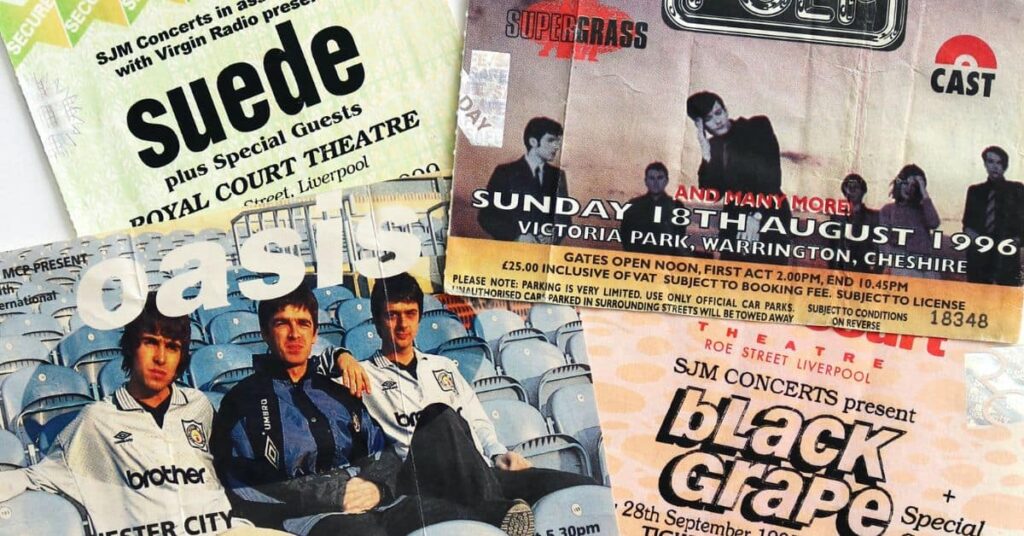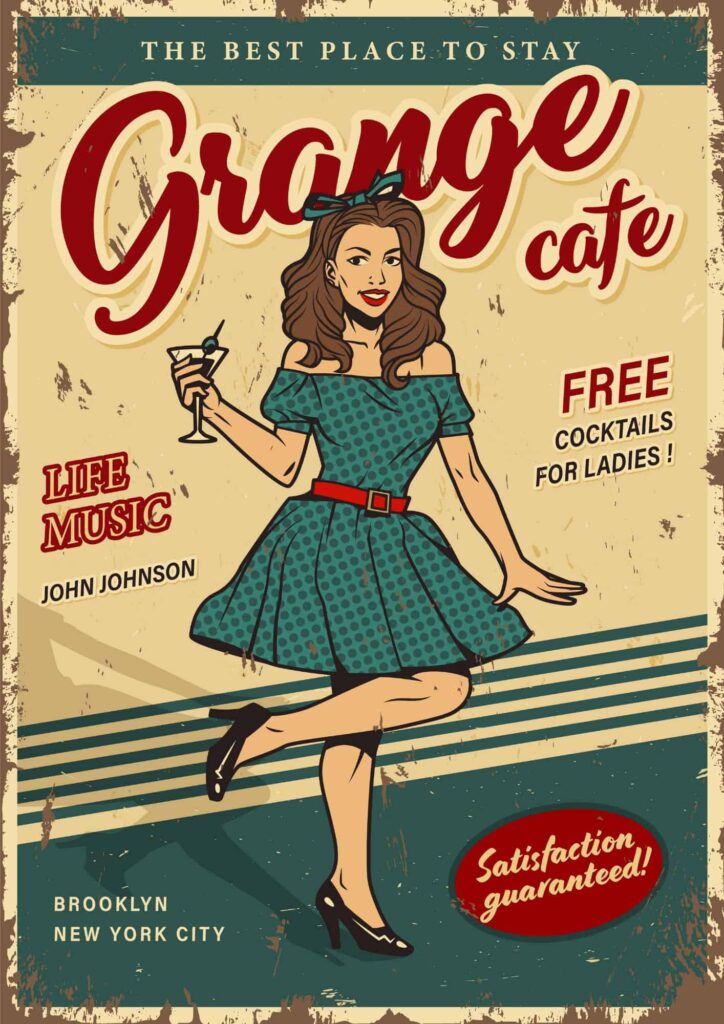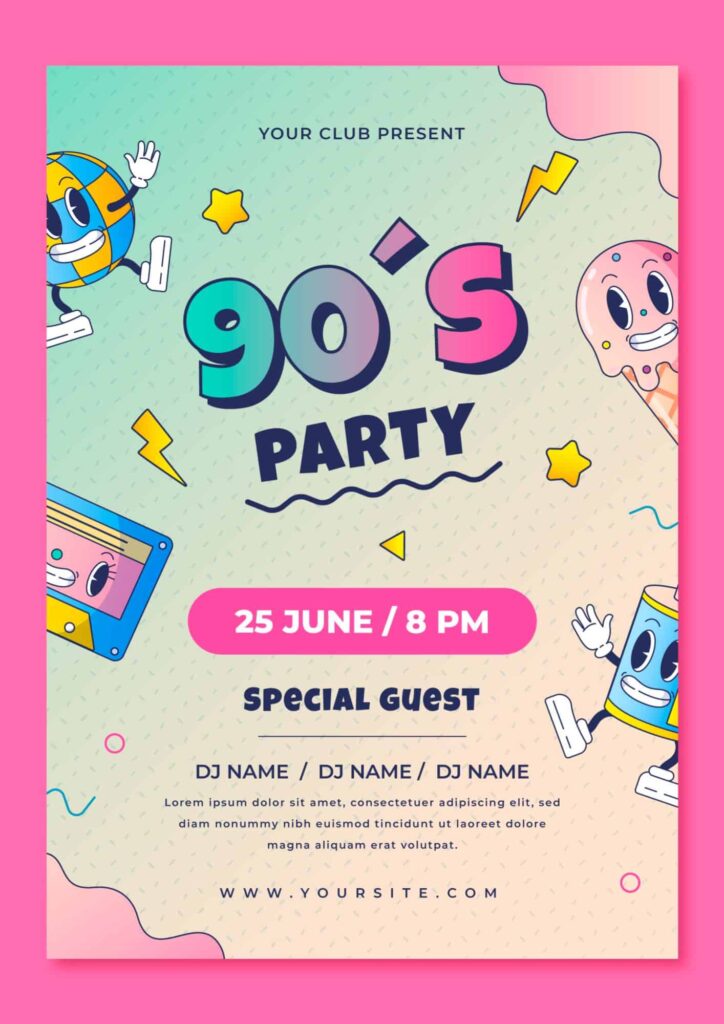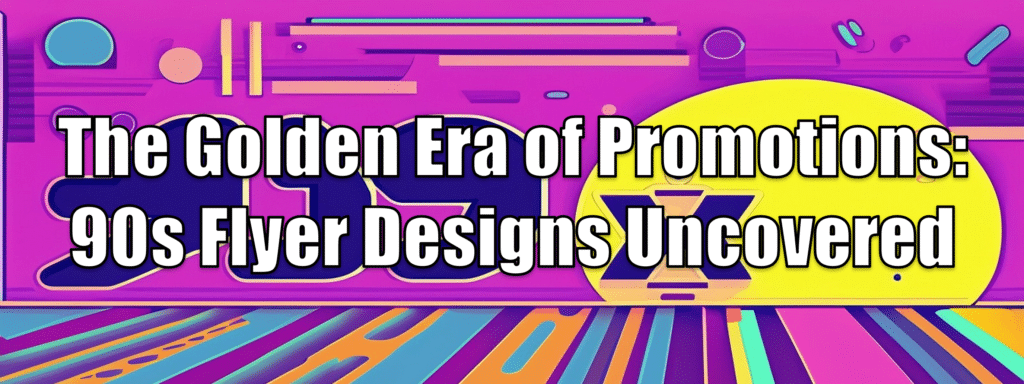The 90s was an era of splendor when promotions thrived. This period saw the emergence of unique ways to promote products and services through a carefully designed 90s flyer. The designs were a popular promotional tool that stood out due to their creative and captivating nature. They featured bright colors, bold fonts, and catchy slogans that effectively attracted attention. The rise of promotions in the 90s paved the way for innovative marketing strategies that continue to influence modern-day techniques.
Table of Contents
The 90s flyer designs were exceptional and diverse. They varied from music flyers with an urban edge to club flyers that stood out with bold typography. The design teams took pride in creating flyers that channeled both the tone of the event and what it promoted. These designs had a lasting impact on those who saw them, influencing their choices over time!
Amidst all this success, there is a hidden treasure trove of unseen designs lost over time. There are still countless undiscovered promotional materials waiting to be brought back to life through digital archives or forgotten paper piles hidden away in attics.
Recently, while cleaning the attic of his grandfather’s home, John stumbled upon posters promoting concerts from long-lost bands from bygone days. The excitement he felt after seeing those vibrant artworks gave him a new perspective on flyer designs and prompted him to start collecting them as an ardent hobbyist.

90s Flyer Design Trends
To understand the creative trends of the 90s flyer designs, and bring those aesthetics to your modern-day promo materials, explore this section on “Flyer Design Trends in the 90s”. In this section, you will learn about the prominent design techniques of that decade, including bold typography and colors, the use of clipart and graphics, and the combination of analog and digital design.
Bold Typography and Colors
The 90s was a ripe time for bold and vibrant design, featuring graphic elements that spoke volumes through color and type.
To maximize impact, flyers incorporated typography with unique and unconventional fonts that were either outlined or shadowed to make them pop. The color selection was significant, with designers choosing bright hues – often neon – to accentuate and highlight text. These aspects came together to create impactful visuals that enticed people to pick up the flyers.
Designers also experimented with different sizes of typography on flyers, mixing big, bold texts with smaller texts in contrasting colors to add depth and dimensionality. They also emphasized key information by adding a pop of color around some words leaving others monochrome or greyed out while using white space effectively, not overcrowding the flyer.
Incorporating these trends can help create a buzz that is more impactful for promotional strategies while catering to audiences who enjoy something different. Being innovative leaves a lasting impression in potential customers’ minds increasing brand recognition within target markets.
Don’t give your competitors an edge by avoiding being too boring; Give more thoughtfulness by incorporating diverse typographic styles embedded into bright contrasting colors for better engagement strategies.

Use of Clipart and Graphics
In the 90s, the incorporation of graphic design elements in flyers gained prominence. The combination of various elements like text, shapes, and images was highly appreciated by the audience. Graphic design became an important communication tool to grab attention and convey a message effectively.
- Clipart was extensively used as they were easily available and added character to the flyers
- Bright colors and contrasting combinations were a common trend
- Geometric figures like triangles and circles were used to create a modern look
- The use of patterns like stripes, dots, or checks created visual interest
- Images with transparency overlaid on top of each other created unique compositions
- Hand-drawn illustrations added creativity and personality to the flyers
Interestingly, the use of graphics in the 90s was not limited to flyers alone. The trend could be seen across various forms of marketing materials like brochures, posters, billboards, etc. The emphasis was on creating visually appealing designs that captured attention instantly without being excessively flashy.
If you want your flyer design to stand out amongst your competition, you need to incorporate creative graphics that communicate your message effectively. Be innovative in terms of color choices, typography, shapes, and images. However, avoid cluttering too many design elements on one page as it may spoil the overall aesthetic appeal.
Don’t miss out on capturing your audience’s attention through effective flyer designs – let graphic design be your ally!

Combining Analog and Digital Design
The integration of analog and digital design elements was a hallmark in 90s flyer design. Combining physical materials like hand-drawn illustrations, cutouts, and collages with computer-generated graphics enabled graphic designers to achieve new levels of creativity. This hybrid approach allowed them to experiment with various textures, colors, and shapes to produce unique designs that captured the attention of viewers and conveyed the message clearly.
In addition to blending analog and digital mediums, designers also utilized distinct typographical styles such as grunge fonts that simulated the roughness of punk rock. These fonts often appeared on top of noisy photographic backgrounds or blended in with handmade illustrations to emphasize a DIY aesthetic.
Pro Tip: Consider combining traditional art forms with digital technologies in your design process for an engaging visual experience.
Back in the 90s, promotions were as popular as frosted tips and butterfly clips on flyers.
Prominent 90s Promotions
To uncover the most prominent 90s Promotions in Concerts and Music Festivals, Nightclubs and Raves, and Sporting Events and Teams, we have come up with a solution. In the section titled ‘Prominent 90s Promotions’ of the article ‘The Golden Era of Promotions: 90s Flyer Designs Uncovered’, we’ll explore these sub-sections to gain a better understanding of their impact on the promotional design culture of the era.
Concerts and Music Festivals
The live entertainment scene during the 90s saw an exceptional lineup of events that captivated audiences around the globe. From grand-scale music festivals to intimate gigs, the era hosted abundant opportunities for music enthusiasts to experience their favorite acts. These events featured iconic musicians and popular genres of the time, creating a unique soundscape that defined the decade.
Some notable events of this era include:
- World-renowned music festivals like Lollapalooza and Glastonbury provided a platform for both established artists as well as emerging talent.
- The rise of boy bands like Backstreet Boys and NSYNC took center stage with their high-energy performances to adoring crowds.
- The emergence of grunge rock in Seattle gave rise to bands such as Nirvana and Soundgarden.
- The resurgence of classic rock icons like The Rolling Stones, Bruce Springsteen, and Queen who continued to produce chart-topping hits.
- The explosion of hip-hop into mainstream culture through artists such as Tupac Shakur, Dr. Dre, and Notorious B.I.G., paved the way for future rap stars.
- The dawn of electronic dance music (EDM) which emerged in underground clubs and gained popularity through artists like Daft Punk and The Prodigy.
While some events did incorporate elements beyond just purely musical performances, such as art installations at Coachella or acoustic sessions at MTV Unplugged shows, they remained largely focused on celebrating live music.
What made these promotions special was not just their lineup but also how they created a sense of community amongst fans. They became much more than just concerts or festivals; they were experiences shared by many that created memories lasting long after the event was over. One such experience is when Metallica famously battled Napster in court over file-sharing rights – a momentous occasion in music history that sparked new conversations on the future of music sharing.
Overall, the 90s transformed the live music scene, and its promotions continue to inspire modern-day events.

Nightclubs and Raves
The entertainment industry in the 90s was full of thriving nocturnal scenes and cultural shifts. These venues were hotspots for nightlifers and clubbers alike, creating an impressive impact on pop culture. The adrenaline-fueled events, filled with light shows and music, saw a new wave of electronic dance music emerge. As clubs boomed in popularity, the onset of clandestine raves was hard to miss too.
These colorful spectacles had everything from local talent to global acts performing, making them irresistible even to those who weren’t huge fans of electronica. Ravers flaunted their style and novelty fashion trends like glowing accessories, graffiti-matched hairdos, and fur boots. The rave community represented a revolution; their gatherings were a peaceful retreat from mainstream culture.
The psychedelic cultures within these soirees still live on today through the archives passed down by their witnesses’ camera rolls. Stories of ecstasy-fueled nights spent dancing in disused warehouses or hidden fields can still be heard today from veterans who remember the uniqueness and authenticity such events carried.
I recall meeting an aging raver at a beach party who shared his tale about sneaking onto military property to avoid getting caught by authorities holding events underground – describing how he longed for just one more rave before finally hanging up his dancing shoes forever. It was clear that while decades had passed since those experiences, they remained incredibly powerful memories worth sharing years later.
Sporting Events and Teams
Sports and their associated teams, a prevalent part of our culture, have enjoyed a rich history of promoting events that have captured the hearts and minds of millions. Throughout the years, these activities have often been performed on a grand scale, typified by impressive displays of athleticism and sportsmanship.
- Some of the most memorable sporting events in history have been those in which great rivalries are formed between two talented teams with something to prove. These competitions inspire passion and excitement among fans across the globe.
- The competitive spirit of sports is often elevated to even greater heights when the stakes are raised through tournament-style events. Tournaments offer competitors an opportunity to showcase their skills over several days or even weeks, culminating in dramatic finales where only one team can emerge victorious.
- Even for those who may not consider themselves avid followers of sports, watching a team’s journey from start to finish in a season can be an emotionally resonant experience. What begins as an investment in one’s favorite team grows into nostalgia-filled memories that last lifetimes.
In addition to these traditional sports experiences, many niche fields also exist – such as martial arts competitions – that offer exciting alternatives for fans looking for unique athletic development.
The 2019 Oceania Sevens Rugby Championship saw eight nations competing in rugby sevens – the format introduced at Olympic games after being absent for 92 years – providing further entertainment and drama to lovers of this much-beloved sport.
The 90s Flyer Template: A Nostalgic Revival of Retro Cool
In the age of digital marketing, the allure of the 90s flyer template has made a triumphant comeback, invoking a wave of nostalgia that resonates with both designers and partygoers alike. These templates effortlessly transport us to a time when neon colors, funky fonts, and pixelated graphics ruled the design scene.
The 90s flyer template captures the essence of a bygone era, offering a vibrant and energetic aesthetic that’s perfect for promoting throwback parties, retro-themed events, and even modern gatherings looking to tap into the vintage cool. With their bold, eye-catching designs, these templates are a testament to the enduring appeal of 90s aesthetics in an ever-evolving world of graphic design. Whether it’s a dance party, a themed night out, or a celebration of all things 90s, these templates are your ticket to a time-traveling experience that’s as visually captivating as it is nostalgically satisfying.

90s Party Flyer Template
Step back in time to the 1990s with our 90s party flyer template. This template captures the fun and vibrant spirit of that era with its retro fonts, bright colors, and nostalgic images like cassette tapes and floppy disks. Whether you’re planning a birthday party, a club night, or any event with a 90s theme, our flyer design is the perfect choice. It’s a great way to bring back the nostalgia of the 90s and create a memorable party experience. So, grab your scrunchies and fanny packs and get ready to party like it’s the 90s all over again!
90s House Party Flyer Template
Step back in time to the 90s with our House Party Flyer Template! It’s perfect for throwing a nostalgic bash or capturing that iconic era’s feel. The template features vibrant colors, cool fonts, and retro designs to promote your event effortlessly. You can easily personalize it with your party details and even add some 90s-style photos.
Impact of 90s Flyer Designs on Contemporary Promotions
The revolutionary 90s flyer designs have left a significant impact on the contemporary promotion industry. The compelling designs, color schemes, and fonts acted as a catalyst to shape the marketing strategies of today. Here, we’ll explore how the creative artwork of flyers from the 90s still inspires modern promotions.
The utilization of innovative digital tools has helped in revamping traditional flyer designs with a 90s touch. The retro aesthetic features continue to evoke nostalgia and catch attention. The unique composition and layout focus on promoting products or events through vivid imagery and intricate typography. Modern designers embrace these techniques for both online and offline promotion.
Alongside the stunning visual appearance, another perk that 90s flyers offer is their cost-effectiveness. Due to advancements in technology, flyers can now be easily printed and distributed at a low cost, making them an excellent option for budget-friendly promotional campaigns.
Although contemporary designers tend to incorporate up-to-date design trends, they should not disregard the effectiveness of classic retrospective graphics that have stood the test of time. By using elements from past decades, marketers can create a new level of interest and excitement among consumers for what would usually be monotonous products or events.

Conclusion: Nostalgia and Inspiration from 90s Flyer Designs
The article sheds light on the nostalgia-inducing and inspiring designs from 90s flyers, which marked a golden era for promotions. The unique design elements such as typography, imagery, and color schemes are analyzed to show how they impacted the audience’s perceptions.
One of the most striking features of 90s flyer designs was their bold use of colors, which were often saturated and vibrant. This helped them stand out in a crowded market and catch the attention of passers-by. Additionally, designers incorporated graphic elements such as geometric shapes and abstract art to make their flyers visually appealing.
Another notable trend in flyer designs during this period was the use of typography. Designers experimented with various fonts and sizes to create eye-catching headlines that conveyed important information while also being aesthetically pleasing.
It is worth mentioning that these flyers were not just functional pieces of advertising material but also works of art that captured the zeitgeist of an era. They represented the cultural values and ideas prevalent at that time.
Pro Tip: While modern flyers have evolved a lot since then, incorporating design elements from this era can lend a nostalgic yet refreshing touch to contemporary promotional materials.
Frequently Asked Questions
What are 90s flyer designs?
90s flyer designs are promotional materials created and distributed in the 1990s to advertise parties, concerts, and other events. These designs heavily feature bright colors, bold typography, and abstract graphics, inspired by the art and music scenes of the time.
Why are 90s flyer designs popular?
90s flyer designs are popular because they capture the nostalgia and cultural significance of the era they originated from. They have become an icon of the 90s music and party scene and are often celebrated for their unique and creative aesthetics.
What makes a good 90s flyer design?
A good 90s flyer design should capture the essence of the event it is promoting while also featuring bold typography, bright colors, and abstract graphics. It should be eye-catching and memorable, reflecting the creativity and uniqueness of the event.
Where can I find 90s flyer designs?
You can find 90s flyer designs online through various design websites or by visiting vintage shops that specialize in retro aesthetics. You can also attend events that celebrate the 90s music scene, where you may be able to find originals or reproductions of the designs.
Can 90s flyer designs be used for modern promotions?
Yes, 90s flyer designs can be used for modern promotions as long as they are appropriately updated to fit current trends and technologies. Many designers and artists have created modern takes on the 90s aesthetic, infusing it with contemporary elements to make it relevant for modern audiences.
Is there any significance to the term ‘Golden Era of Promotions’?
The term ‘Golden Era of Promotions’ refers to the period of the 1990s when flyer designs were at their peak in popularity and creativity. It is often celebrated for its significant impact on design culture and for creating a lasting legacy in the world of graphic design.




